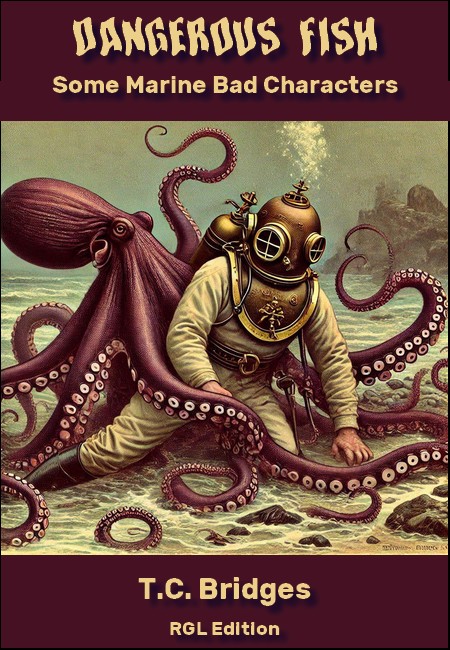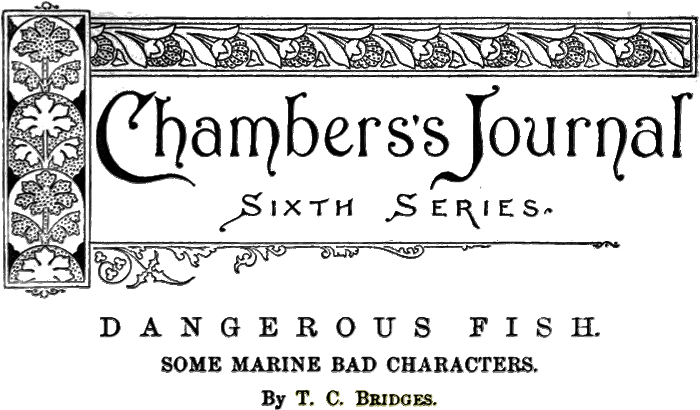
RGL e-Book Cover
Based on an image created with Microsoft Bing software
Roy Glashan's Library
Non sibi sed omnibus
Go to Home Page
This work is out of copyright in countries with a copyright
period of 70 years or less, after the year of the author's death.
If it is under copyright in your country of residence,
do not download or redistribute this file.
Original content added by RGL (e.g., introductions, notes,
RGL covers) is proprietary and protected by copyright.

RGL e-Book Cover
Based on an image created with Microsoft Bing software


THE idea of fish constituting a danger to human life or limb would hardly occur to the angler who has never cast net or line in tropical waters. Yet even in our own British seas and rivers we have at least two fish which possess the power to make themselves extremely unpleasant. There are several instances on record of bathers being attacked by pike, and an old writer, Crull, tells of a giant pike inside which was found the body of an infant. Not long ago a good-sized retriever which was swimming in the Thames just above Chitty's boathouse at Richmond was tackled by a pike, which bit one of its hind legs so badly as to sever an artery. It was another Thames pike which attacked that well-known naturalist and fisherman, Mr Cholmondeley-Pennell. He had actually landed the fish, when it sprang from the ground and fixed all its sharp teeth into his leg just above the knee. The creature hung so fiercely to its hold that a stick had to be used to prise its jaws apart.
The other British fish which can truly be called dangerous is the conger-eel. The experienced sea fisherman takes care to kill every large conger as soon as it is brought into the boat. The conger has not only extraordinary jaw-power—it can triturate shellfish, shells and all—but is also so abominably active that the fisherman's opinion of it coincides with that held of the Indian by the Western plainsman: 'No good conger except dead conger.'
Ugly and savage brute as the conger is, it is a lamb compared with its relative the green moray of Bermudian waters. This great eel is of an unnaturally brilliant green, and has an eye which is the very epitome of intense and malignant ferocity. It is voracious and savage beyond words. The negro boatmen have such a holy horror of it that they absolutely refuse to allow a moray into the boat. An acquaintance of the writer, a marine officer, fishing in a small boat off Bermuda, hooked one of these fish; but as soon as his boatman saw the hideous head above the water he whipped out his knife and made to cut the line. The officer shouted to him to stop, but had to threaten to throw the man overboard before he would put up his knife. When the great eel was pulled over the side the nigger went absolutely ashy with fright. As for the moray, no sooner was it in the boat than it doubled upon itself, and its jaws met with a clash in its own side, cutting out a chunk of white flesh as neatly as a scoop would cut cheese. That was enough for the officer. He picked up a boathook and forked the uncanny creature overboard. Five years ago last June a green moray twelve feet long came ashore after a storm at Atlantic City, and was found by a coastguard on the beach. The man took it for a sea-serpent, and thousands of holiday-makers came to stare at it. It is described in a local paper as having 'full red lips and a double row of teeth.'
Of course the great peril and pest of tropical waters is the shark. Never so long as he lives will the writer forget his first experience of a shark. Years ago he was staying at Ormond, on the Atlantic coast of Florida, the same beach where the great motor speed-contests are now held. Early on the first morning of his arrival he went down to bathe, and, passing through the breakers on the bar, swam out to sea. Suddenly the familiar triangular fin appeared not fifty yards away, and then the whole back of a shark showed through the broken water. It was not a very large shark, and probably quite harmless, but the writer broke his own and most other existing swimming records back to the bar. Yet a shark's bark, so to speak, is worse than its bite. There has never been a case of a man being taken by a shark on the Atlantic coast of Florida north of Biscayne Bay; and though the Gulf fairly swarms with the ugly brutes, it is safe enough to bathe in a crowd and near shore. But the authorities will not let you dive off the end of a steamship pier on that coast, and rightly so. Very large sharks are sometimes caught in British waters. Five years ago fishermen from Kinsale found in their nets a blue shark ten feet three inches in length, which had inside its stomach three smaller sharks, each about four feet in length. Occasionally a blue shark is seen or caught on the Cornish coast; but they are very rare, and certain alarmist letters which have appeared in London daily papers on the subject of sharks and bathers are quite unjustified by facts.
The strangest shark story which ever came to the writer's ears was of a shark that charged a steamer. This was in Queen Charlotte's Sound, and an account of the incident appeared in a Vancouver paper. The captain of the steamer, which was a small craft of only fifty tons or so, saw the shark on the surface on the port bow, and could not resist the temptation of taking a shot at it with his rifle. He hit his mark, whereupon the monster—said to have been fully twenty feet in length—deliberately charged the steamer. The boat quivered from stem to stern, and the captain said afterwards that it was like striking a rock. After this display of temper Master Shark had had enough of it, and sank out of sight.
A fish that has a thoroughly bad name in West Indian waters and all along the shores of the Mexican Gulf is the barracouta. Certainly the barracouta is an unpleasant-looking customer. He is long and narrow, shaped like a torpedo, blue-black above and gray below, and he can swim at most amazing speed. Where he lives he is known as the devil-fish, a name common to all marine bad characters. Negroes have a perfect horror of the barracouta, which they aver will attack bathers and inflict upon them a mutilation impossible to describe. But whether there is any ground of truth in this accusation, which is also made against a fresh-water fish found in the Amazon, the writer has never been able to ascertain.
Another so-called devil-fish which is common on American coasts from thirty degrees north latitude to about the same degree south of the line is the giant ray. This fish looks very like a skate, but grows to an enormous size. It lies on the sea-bottom, covering square yards of coral sand, and if attacked may prove not only nasty but most dangerous. It is said to use its mouth like a shark, but its most unpleasant weapon is the toothed spear in its tail. Fishermen aver that it is able to drive this jagged lance right through a man's thigh. Such a wound is extremely poisonous, and almost invariably fatal. In the southern part of the Gulf of Mexico specimens of the giant ray have been killed up to eighteen feet across. The ray has two horns, one on each side of its eyes, the latter being green, hideous, and cruel beyond compare. A curious habit of this fish is to break water like a whale, failing with a thunderous splash which is heard for miles.
Some years ago a most strange case of a fatal accident caused by a fish was reported in the British Medical Journal by Dr S. Osborne Browne, of British Honduras. A boy went out to fish at the island called Cross Caye, when a fish known as the long-guard rose from the water and struck him on the bare chest, causing a punctured wound which proved fatal. Such an occurrence would seem almost incredible, but full details are given by Dr Browne. The fish was two feet three inches in length, and weighed one pound nine ounces. It had a sharp snout three inches long. The long-guard has the power of rising from the water and flying with great velocity for many yards. Cases were previously known of specimens passing through the sail of a boat and even penetrating the side, but this was the first instance on record of human life being lost through the long-guard's agency.
In the British Museum may be seen a specimen of a heavy oaken plank, once part of the bottom of a stout vessel, which has been pierced by the sword of a sword-fish. The weapon remains fast fixed in the timber. Along the Atlantic coast of the United States sword-fish are hunted both for their flesh, which is palatable, and also in order to protect the schools of blue-fish and mackerel which they ravage. Usually a sword-fish when harpooned swims straight away, just as a whale would do; but sometimes a large specimen will turn nasty and attack the boat. As its speed is simply tremendous, exceeding even that of a dolphin, the impact of half a ton or more of bone and muscle will drive the great beak through almost any timber, and bad accidents are sometimes heard of. There used to be an elderly pensioner at Old Point Comfort, Virginia, who had lost a leg through a wound received when engaged in sword-fishing. Whenever the sword is driven through a boat the men invariably do their best to break it off; for it is an odd fact that, once deprived of its natural weapon, the sword-fish instantly loses all its natural savagery and becomes harmless as a herring. Sword-fish hunters say that there is a natural enmity between the sword-fish and the shark, and tell stories of desperate duels between the two antagonists. The superior agility of the former makes up for the greater power and weight of the shark.
Of all sea-monsters, that which possesses the most powerful fascination for the general reader is undoubtedly the octopus. Some of the finest descriptions ever penned in fiction have related to duels between man and this horrible denizen of the rock-caverns of the sea-bottom. Victor Hugo was the first great novelist to describe a duel of the kind, and another very fine description of a similar contest is to be found in a novel by a writer whose work is familiar to readers of Chambers's Journal—namely, Barbe of Grand Bayou, by John Oxenham.
Ghastly and blood-curdling as these adventures read, fiction in this case falls far behind fact. About eleven years ago—it was in September 1897—there was a note in Chambers's Journal concerning the remains of a dead octopus thrown up by the sea upon the Atlantic beach near St Augustine, Florida. These remains, which were only a part of the living animal, weighed no less than six tons, or, say, twice the weight of an average full-grown elephant. The living animal must have had arms seventy-two feet in length, which means that the creature, when alive, was able to stretch a distance of nearly one hundred and fifty feet. We jeer at newspaper descriptions of sea-serpents. Could the most grue some conception of the brain of excited journalist exceed in size or horror such a monster of the deep as this?
There are several varieties of the cephalopoda, from the common octopus which is frequently caught off the Cornish coast, and of which there are some fine specimens in the Marine Laboratory at Plymouth, up to the Octopus giganteus, of which the mass washed ashore in Florida was a portion. They are found in all seas except the far Arctic, and they need not be very large to be dangerous to man. There are some in Leghorn harbour with arms not more than four or five feet long, which yet inspire the utmost terror among the fishermen. In November 1879 a Government diver at work in the tideway of the river Moyne at Melbourne was seized by an octopus of similar dimensions, which fixed its horrible cup-like suckers on the back of his bare right hand and round his arm. For twenty minutes he hammered the loathsome brute with an iron bar which he managed to seize in his left hand; but it was not until he had almost cut the creature to pieces that it relaxed its grip, and he and it were pulled to the surface together.
Some of the largest of these true devil-fish are found around the rocky shores of Newfoundland. In the museum at St John's is a portion of an arm of one of these monsters which in October 1873 attacked two fishermen off Great Belle Island in Conception Bay. The men saw the creature floating on the surface at some distance, and, taking it for wreckage, rowed up. When they caught sight of its huge glassy eyes staring up at them they were almost paralysed with fright, and, before they could turn, two rope-like arms fell across their boat and completely enveloped it. With the courage of despair, one man grasped a hatchet and slashed furiously at the tentacles. He cut them both through; and the creature, ejecting such a quantity of ink as to blacken the water for many yards around, sank back into the depths. The piece that was preserved measures nineteen feet in length, and it is estimated that it was cut off at least six feet from the body.
In April 1899 a terrible battle between man and devil-fish was waged in Neah Bay, on the western coast of the United States. A number of Tatoosh Indians were out in their canoes fishing with harpoons, when one caught sight of what he took to be a small whale rising and falling on the waves. The largest canoe was hurried forward, but as it approached the creature the harpooner uttered a cry of terror. 'Big devil-fish!' he yelled, and the crew backed with all their might. Too late! Next instant the immense tentacles of the sea-monster grasped their craft, and, though it was a forty-foot sea-canoe, cracked it like an egg-shell. All five occupants were flung into the sea, and as they fell two were grasped by the living ropes. One was caught round the throat and killed almost instantly; the second was pulled underneath and drowned. At this the other Indians paddled up, and a shower of lances were driven into the bloated, jelly-like body of the devil-fish. Between them they killed it and towed it ashore, where it was photographed by a local naturalist, Mr Frederick Edwards. From tip to tip of its outstretched arms this nightmare of the deep measured fifty-six feet, and its weight was two thousand five hundred pounds. On each arm were three hundred and fifty suckers running from the size of a saucer down to a mere pin-point.
According to Mr Bullen,the squid or cuttle-fish is the principal food of the sperm-whale. But apparently the game is not always one-sided. The same author relates a thrilling incident of a huge sperm-whale rolling on the moonlit surface of the sea enveloped in the mighty coils of an octopus far larger than any of which even fragments have yet been handled by man.
Roy Glashan's Library
Non sibi sed omnibus
Go to Home Page
This work is out of copyright in countries with a copyright
period of 70 years or less, after the year of the author's death.
If it is under copyright in your country of residence,
do not download or redistribute this file.
Original content added by RGL (e.g., introductions, notes,
RGL covers) is proprietary and protected by copyright.